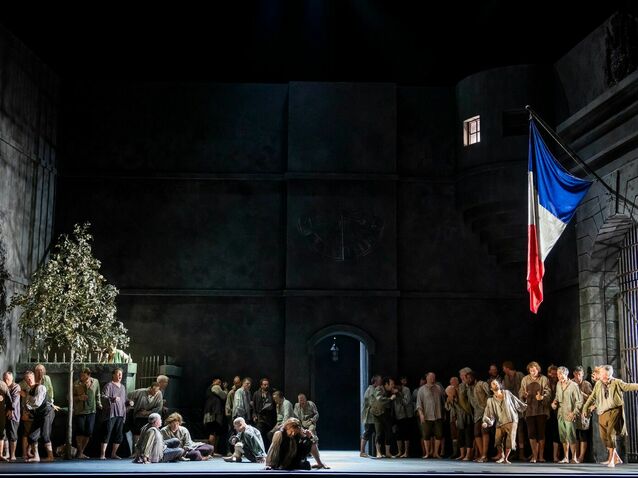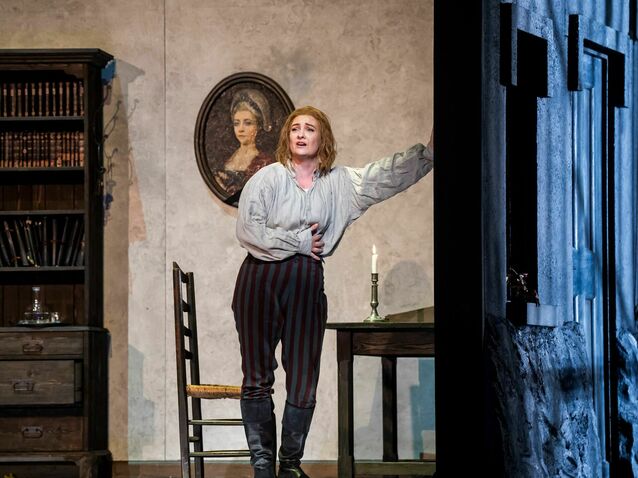 © Tristram Kenton
© Tristram Kenton
Fidelio is the only opera that Beethoven ever wrote. Originally entitled Leonore, oder Der Triumph der ehelichen Liebe, with the libretto prepared by Joseph Sonnleithner from the French of Jean-Nicolas Bouilly, it premiered at the Theater an der Wien on 20 November 1805. The following year Beethoven’s friend Stephan von Breuning rewrote the libretto to create a second version that shortened the opera from three acts to two. In 1814 Beethoven revised his opera yet again, with additional work on the libretto carried out by Georg Friedrich Treitschke. This third and final version was first performed at the Kärntnertortheater on 23 May 1814, and by current convention is the only one of the three to be known as Fidelio as opposed to Leonore. It is the only version that is regularly performed today, although the three Overtures that he wrote for the previous two often feature in concerts.
Originally set in a Spanish state prison in the late seventeenth century, the background to the story concerns a feud between two noblemen, Florestan and Don Pizarro. Florestan attempted to expose certain crimes of Pizarro, who exacted revenge by jailing him in the prison of which Pizarro was the governor. At the start of the opera Florestan is being secretly held in an underground dungeon, being slowly starved to death. Don Pizarro has already spread false rumours that he is actually dead, but Florestan’s faithful wife Leonore suspects otherwise, and, disguised as a boy named ‘Fidelio’, gains employment working for the prison’s gaoler Rocco. She still faces many difficulties in finding her husband, however, as Rocco will not let her near Florestan’s dungeon, and she also has to contend with Rocco’s daughter Marzelline having fallen in love with her, believing her to be a boy. There is also a ‘ticking clock’ as Pizarro learns that the King’s Minister Don Fernando plans a surprise visit the following morning, and determines to murder Florestan and bury his body before the Minister’s arrival. By outwitting everyone else, Leonore succeeds in reaching Florestan in the nick of time and preventing his murder, so that when Don Fernando arrives the governor’s evil deeds are exposed as all sing the praises of Leonore, the loyal saviour of her husband.

Tobias Kratzer's production of Beethoven's Fidelio, The Royal Opera ©2024 Tristram Kenton
Tobias Kratzer’s staging of Fidelio premiered at the Royal Opera House in March 2020, with Lise Davidsen playing Leonore and the role of Florestan being taken across the run by Jonas Kaufmann and David Butt Philip. However, the final performance, which was due to be broadcast live in cinemas, never took place as COVID-19 took hold. This is the first time that the production has been seen at the venue since, and is revived on this occasion by Anja Kühnhold. Kratzer updates the action to the French Revolution, arguing that even Beethoven’s first audiences would have identified the plot with that episode, and that the nominal setting of Spain was merely to avoid controversy and the censors. In the process, Kratzer asks us as the audience what part we would have played in that event, and, in line with the setting, the prison is shown to be a place of much activity and brutality. Rainer Sellmaier’s set reveals its courtyard, and during the Overture a group of women rush on to see a bunch of severed heads, hoping either to retrieve those of their lost lovers or conversely to check that their husband is not among the dead. Overall, the setting feels quite realistic, and Rocco’s own rooms in the prison are sometimes revealed by having them pulled out from the wall in which they would be found. His dwelling is certainly Spartan but it looks tidy and well maintained, while a picture on the wall could be that of his (presumably dead) wife.
Kratzer created the dialogue used in this production himself, basing it on the original libretto and additional texts by Georg Büchner and Franz Grillparzer. He makes Don Pizarro a Robespierre-style figure, who, in line with the attitude typically attributed to that historical person, declares that anyone who shows any sign of fear is clearly guilty. This creates a few difficulties because how could such a revolutionary be satisfied with Rocco’s claim that the prisoners have been freed to roam the courtyard to mark the King’s name day? Nevertheless, the vast majority of potential problems associated with the decision are addressed over the course of the evening. In the first half, we may be thinking that associating Don Pizarro with terror and revolution means associating the virtuous Don Fernando with the ancien régime, which would imply that the revolution was all bad while what it overthrew was completely good. The second half does, however, bring clarity to all of these issues.

Eric Cutler as Florestan in Tobias Kratzer's production of Beethoven's Fidelio, The Royal Opera ©2024 Tristram Kenton
With the setting in Act I feeling quite realistic, one might have expected Florestan’s dungeon in Act II to have been portrayed in all its darkness, loneliness and horror. Instead, it is represented by a white floor and rear wall, while the entire chorus sits on chairs surrounding the prisoner. This change in tone is deliberate on Kratzer’s part as he believes Fidelio ‘falls into two unequal halves. Act I is a historical melodrama on freedom and love in the post-Revolutionary era. Act II is a political essay on the responsibility of the individual in the face of a silent majority, a musical plea for active empathy’. This explanation does not feel entirely satisfactory because it is often the consistency of a staging that helps people to invest emotionally in a scenario by immersing themselves so completely in it. Therefore, encouraging them to see things in one way before switching to something completely different can act as a check on their ability to feel involved in what is presented, as it takes time to adjust to the ‘new reality’.
In all other respects, however, the change works well and delivers exactly what Kratzer intended. In particular, it puts us as the audience right at the centre of the drama. Before the opera begins a live image of the auditorium, and thus audience, is projected onto a front cloth that proclaims ‘Liberté, Égalité, Fraternité’. The mass of people seen in Act II, some of whose images are also projected onto the back wall, thus mirror us, and the point is that they sit silently doing nothing. One actually eats chocolate while Florestan starves, and another contemplates offering him water but ultimately decides not to get involved. The question is whether we too, if put in a similar situation, would be complicit in perpetrating horrors through fear and an unwillingness to stick our necks out. The chorus do finally spring into action, and kill the oppressive guards, but only after Leonore has led the way and already put Don Pizarro on the back foot. In a sense, therefore, their own violent actions could be seen as deriving from a desire not to end up on the losing side. Nevertheless, we can still say that loyalty and truth win out in the end, with the battle between Don Pizarro and Don Fernando not so much being a battle between Robespierre and the ancien régime, but between the bad and good sides to revolution.

Jennifer Davis as Fidelio in Tobias Kratzer's production of Beethoven's Fidelio, The Royal Opera ©2024 Tristram Kenton
Jennifer Davis, who played Elsa in Lohengrin here in 2018 and 2022, proves to be an immensely accomplished Leonore. With a beautiful soprano that always displays a combination of freshness and richness, she is every inch the intelligent and determined figure who constantly puts truth and her husband’s welfare above her own safety. Eric Cutler, with his ringing tenor that also proves to be very secure, takes the stage by storm in ‘Gott! Welch Dunkel hier!’ and ‘In des Lebens Frühlingstagen’.
With his firm bass and strong presence, Peter Rose is a class act as Rocco, as is Christina Gansch as Marzelline whose sumptuous soprano is quite thrilling. There is fine support from Jochen Schmeckenbecher as Don Pizarro, Michael Gibson as Jaquino and Phillip Rhodes as Don Fernando, while the chorus is also on excellent form. The men’s chorus excels in particular in ‘O welche Lust’, in which there are also splendid contributions from the two Prisoner soloists Siphe Kwani and Eugene Dillon-Hooper. In the pit, Alexander Soddy elicits a striking sound from the Orchestra of the Royal Opera House that feels both robust and appropriately nuanced.
There is ultimately a great attention to detail throughout. In this production, there is a moment in Act I when Marzelline realises that Fidelio is not a boy. However, while she might have exposed Leonore because she felt betrayed, she reveals much about her own character by not doing so, and plays quite an active role in the opera’s close. Similarly, right at the end the entire cast and chorus come to the front of the stage, as if they have burst out of the stage’s frame. This has the dual effect of making them feel very much at one with us, as the lights also go up on the auditorium, and ensuring that the final bars feel the most overwhelming of the entire opera because they can be so powerfully projected.
By Sam Smith
Fidelio | 9 - 26 October 2024 | Royal Ballet and Opera, Covent Garden
the 12 of October, 2024 | Print
Comments